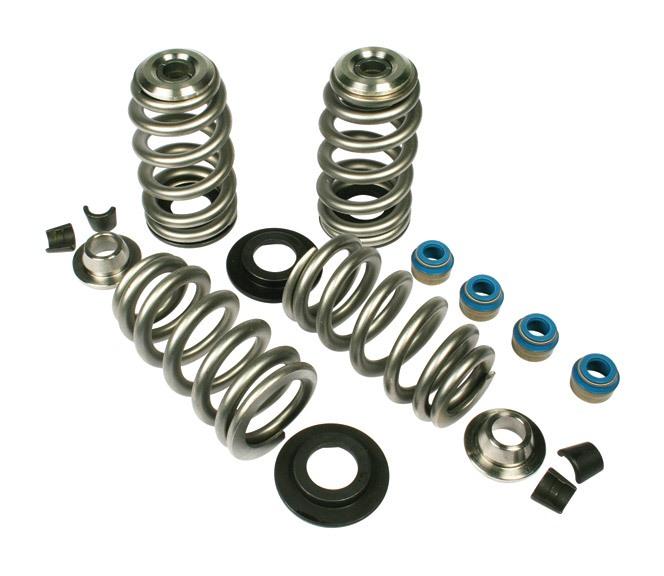Screamin' Eagle 110 Valve Springs: Everything You Need to Know (Before You Rip It!)

If you're deep into the world of Harley-Davidson performance builds, you've probably heard whispers — or maybe roars — about Screamin' Eagle 110 valve springs. Whether you're chasing a smoother idle, higher RPMs, or just a more durable valvetrain setup for your beastly 110-cubic-inch engine, understanding these bad boys is absolutely crucial.
So, grab your wrench and your energy drink, because we’re diving deep into why Screamin' Eagle 110 valve springs are more than just hype. 🏍️🔥
First Things First: What Are Valve Springs, Anyway?
In case you skipped engine mechanics class (no judgment), valve springs are the unsung heroes inside your motor. They keep the valves tightly sealed against combustion pressure and snap them closed at the right moments during the engine’s cycle.
Without strong, properly rated valve springs, you get:
- Valve float (scary at high RPM)
- Loss of power
- Engine damage (in the worst-case scenario)
Especially when you start modifying for bigger cams, higher lift, or crazy RPMs — your stock valve springs just won’t cut it anymore.
Meet the Screamin' Eagle 110 Valve Springs
The Screamin' Eagle 110 valve springs are specifically engineered by Harley-Davidson’s own performance division to handle the demands of their CVO 110 engines and Screamin’ Eagle performance upgrades (Harley-Davidson Screamin' Eagle Catalog, 2024).
Here’s what makes them stand out:
- Higher spring pressure: Essential for aggressive cam profiles and higher RPMs.
- Increased lift capacity: Designed to handle camshafts with lifts up to .585" and sometimes higher depending on setup.
- Dual-spring design: Two concentric springs provide redundancy and added strength to resist coil bind and fatigue.
- Heat treatment and shot peening: Extended durability and fatigue resistance for those long rides (or burnouts at the local bike night).
Translation: They’re built tough so you can rip harder and faster without grenading your engine.
Why Upgrade to Screamin' Eagle 110 Valve Springs?
1. Bigger Cams Demand Better Springs
If you’re installing a performance camshaft like the Screamin' Eagle SE-259E or other aftermarket monsters, stock springs simply can't manage the higher valve lifts and more aggressive ramps.
You risk valve float, where the spring can't close the valve quickly enough. Result? You lose compression, power, and maybe even smash a valve into a piston (ouch 💀).
2. Higher RPM Range
Stock Harley engines are built for torque down low, not screaming up at high RPMs. But when you upgrade — new cams, better exhaust, race tune — you push the redline higher. Stronger valve springs mean reliable performance even when you're spinning up to 6,500+ RPMs (Hot Bike Magazine, 2023).
3. Long-Term Durability
The better metallurgy, precision winding, and surface treatment of Screamin' Eagle springs mean they’ll resist fatigue, heat cycles, and mechanical stress better than stockers.
Translation: More miles, fewer headaches.
Installation Tips: Don’t Wing It
Upgrading valve springs isn’t brain surgery, but it’s definitely not bolt-and-go either. Here's how to avoid rookie mistakes:
✅ Measure Coil Bind
Always check coil bind clearance when installing new cams and valve springs. You want at least .060" clearance at full lift, minimum. Otherwise, catastrophic spring failure could happen.
✅ Check Installed Height
Make sure you verify the installed height (the compressed height when the valve is closed) is within the spec for the Screamin' Eagle springs — usually around 1.800" to 1.850" depending on your exact setup.
Use proper valve spring shims to adjust if needed.
✅ Consider Upgrading Retainers and Keepers
While you’re at it, you might as well beef up your retainers (preferably titanium) and keepers to match the stronger springs. A weak retainer could fail under load and wreck your head — not cool.
Real-World Rider Feedback
🏍️ John M., Miami:
"I installed Screamin' Eagle 110 springs when upgrading to the SE-259E cam. Night and day difference. Before, it felt lazy at 5K RPM — now it screams right up to 6500 without breaking a sweat."
🏍️ Lisa R., Perth:
"Worth every cent. My CVO 110 pulls way harder, and the engine sounds way tighter too. Just make sure you measure EVERYTHING if you're mixing and matching parts."
🏍️ Tony B., Austin:
"Springs plus new pushrods and lifters turned my bagger into a rocket ship. Best part? 10,000km later and still no weird noises or valve issues."
Things to Watch Out For
- Spring Surge: Happens if your cam profile and spring rate aren’t matched right. It can cause harmonic oscillations and early fatigue.
- Pushrod Geometry: Incorrect length pushrods after head work or cam upgrades can cause excessive stress on the valve train.
- Clearance Issues: High-lift cams can cause valves to hit pistons if you don’t check piston-to-valve clearance. Always clay-check during assembly.
Final Verdict: Are Screamin' Eagle 110 Valve Springs Worth It?
Absolutely. If you’re modifying your Harley 110 engine — adding cams, pushing RPMs, or just want extra durability — the Screamin' Eagle 110 valve springs are an essential upgrade.
They’re designed to work seamlessly with other Screamin' Eagle components, so fitment is usually drama-free (as long as you double-check your clearances). And because they're a genuine Harley-Davidson product, you get peace of mind that they were built to last — not just look cool on a spec sheet.
Bottom line: If you’re serious about making your Harley rip, don’t sleep on the valve springs. It’s a small investment for a massive payoff. 🛠️⚡
References:
- Autos
- Art
- Causes
- Crafts
- Dance
- Drinks
- Film
- Fitness
- Food
- Games
- Gardening
- Health
- Home
- Literature
- Music
- Networking
- Other
- Party
- Religion
- Shopping
- Sports
- Theater
- Wellness
